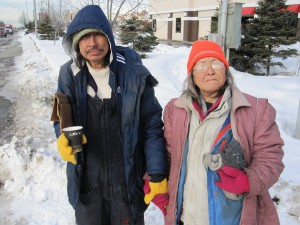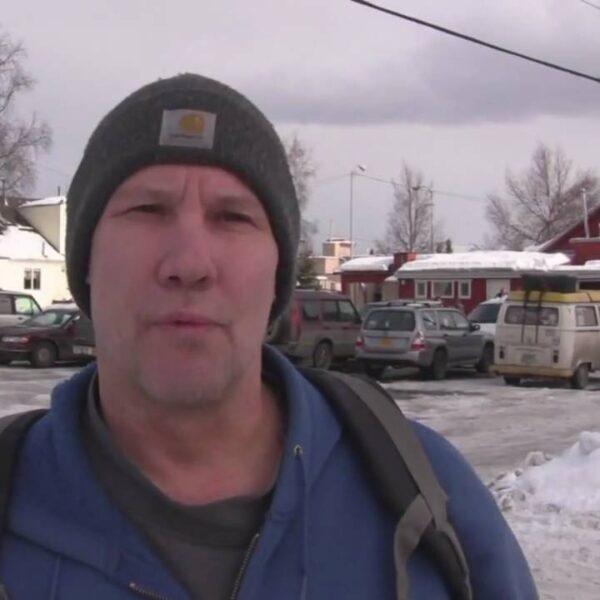Alaska’s Homeless Problem Is an Alcohol Problem
Until my recent trip to Anchorage, Alaska, I had never heard the term “Chronic Public Inebriate,” yet in Alaska the word “inebriate” is spoken everywhere. It is so grafted in Anchorage’s culture that even the homeless call themselves inebriates. At first it bothered me, but I soon learned that Anchorage’s homeless problem is very complex, caused by severe alcohol addictions.
People who are normal drinkers and have never touched life with an alcoholic often think quitting booze is a choice. Unfortunately, the nature of alcoholism takes away any free will, making the alcoholic as dependent on alcohol as he is on air.
My own life may help illustrate:
I was an abnormal drinker. One night at 14 years old, I drank a half gallon of whisky all by myself. That amount would kill most people. I never passed out, but I did black out. The next day my elbows were the size of softballs, swollen because I must have fallen most of the night. An experience like this should have been a warning, but I continued to drink.
At 17 years old, on New Year’s Eve, the New York State Police found me passed out in a snowbank alongside a freeway. I could have died, yet I remember my only regret was that I never made it to midnight. Again, the seriousness of my problem didn’t sink in. Even though alcohol could have killed me that night, I kept on drinking.
When I worked for Starcom Television, I plowed my Mercedes into a parked Cadillac. I blew a .28, which is three times the legal limit to drive. LAPD had me blow into a breathalyzer twice because they thought their equipment was broken. The officers said they had never seen anyone with such high alcohol content function as normally as I was. Sadly, even though I could have killed someone, I still didn’t think I had a problem, and I still kept on drinking and abusing drugs until I ended up on the streets, homeless. Even then I needed help to get sober. On my own, I would have continued a life of drinking madness.
I was not ready for what I experienced
On my first day in Alaska, I wrote about watching a man stumble down the street so drunk he fell into a snowbank. We called 911, and the man was taken to what the city calls a “sleep -off.” During my first two days, I visited with a few homeless service providers, met and interviewed Mayor Sullivan, and spoke to several people on the streets. The story that kept being told over and over again was not so much the issue of homelessness, but a severe alcohol problem among the Native Alaskans. I was told three of the homeless people found dead were found with empty Listerine bottles next to them. Listerine is 26.9 percent alcohol, making it approximately 54 proof. When stores are closed, or sale is refused, people addicted to alcohol drink Listerine. (Meet Kim on InvisiblePeople.tv)
Seen Through The Eyes Of Sgt. Allen
 Honestly, I was not ready. For close to 14 years I have been working in homeless services at some capacity. I have literally walked into tent cities all over America. But I had never seen homelessness through a cop’s lens. In my interview with Mayor Sullivan, the topic of public safety came up, and I must agree with him that homelessness is not only a health issue but a public safety issue.
Honestly, I was not ready. For close to 14 years I have been working in homeless services at some capacity. I have literally walked into tent cities all over America. But I had never seen homelessness through a cop’s lens. In my interview with Mayor Sullivan, the topic of public safety came up, and I must agree with him that homelessness is not only a health issue but a public safety issue.
Sergeant Allen of the Anchorage police department allowed me to ride along with him to give a 12-hour warning at an illegal homeless camp. We met at a substation along with a local NBC news crew. Although I have ridden in police cars more than most, this was my first time being in the front seat. Sgt. Allen gave me the vest to put on, and a dispatch call came in for a drunk driver.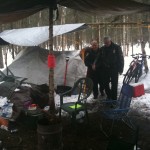 He said there was not enough time for the rules and asked me to fill out a waiver. I simply asked for the do’s and don’ts. Sgt. Allen responded, “If I get out of the car I want you to get out of the car. If shooting starts, I want you to run in the opposite direction!” That’s easy enough, I thought, as the reality of what was about to happen set in.
He said there was not enough time for the rules and asked me to fill out a waiver. I simply asked for the do’s and don’ts. Sgt. Allen responded, “If I get out of the car I want you to get out of the car. If shooting starts, I want you to run in the opposite direction!” That’s easy enough, I thought, as the reality of what was about to happen set in.
There is very little room in the front seat of a police car. Added to that, I was wearing a vest and winter coat! I could hardly move. It was kind of eerie driving through Anchorage’s “hood.” People were just standing on the curb, up to no good. I knew what they were doing, and Sgt. Allen knew all of them by name. We drove around for a little bit then headed off to meet three more officers to visit the tent camps. This next video was shot on at the first camp we visited.
I started to see a new side to homelessness. Aside I knew was there, but had never experienced. As I walked into the camps, and as I talked to Sgt. Allen and his team, I started to see how dangerous and unsafe homeless camps are. Not all homeless camps. Nickelsville, for example, was self-governed and kept clean and orderly. But Nickelsville is rare.  As I started to see homelessness as a public safety issue, I also started to feel for the people living in these camps. They’d have to move with nowhere to go. The one man who was ‘home’ didn’t want to go on video. He told me his story, and it broke my heart. He didn’t have any place to go, and I could feel his fear. He pointed at a twelve-pack of empty beer cans, telling me that was what had ruined his life. He couldn’t stop drinking no matter how hard he tried, and he had lost everything. He had lost his job and his family, and now he was out in the cold with no place to go.
As I started to see homelessness as a public safety issue, I also started to feel for the people living in these camps. They’d have to move with nowhere to go. The one man who was ‘home’ didn’t want to go on video. He told me his story, and it broke my heart. He didn’t have any place to go, and I could feel his fear. He pointed at a twelve-pack of empty beer cans, telling me that was what had ruined his life. He couldn’t stop drinking no matter how hard he tried, and he had lost everything. He had lost his job and his family, and now he was out in the cold with no place to go.
I have to tell you first hand that I was very impressed with Sgt. Allen and the Anchorage police. They have a hard job, and they were professional and showed compassion at all times. I know cops often get a bad rap, but I’ve seen compassion when working with Glendale Police and Greensboro Police.
After we left the camps, Sgt. Allen drove around Fairview, the section of Anchorage that has the most trouble. We found a man passed out next to a liquor store. I was impressed by how Sgt. Allen was firm, yet treated this man with respect. Sgt, Allen helped the man into the police car, and we drove to the “sleep-off” center. 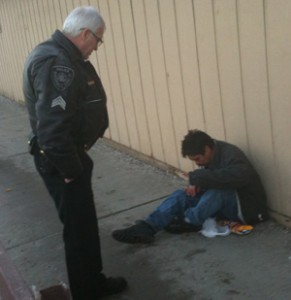 This is a section near the jail that is basically a large room with mats on the floor and a few chain link fences for separation. There is no official booking. A breathalyzer is given, and the person is then allowed to sleep until the alcohol wears off. I was told many of the “inebriates,” as they are called, blow a .30 or higher and are still functioning. Unfortunately, this system is nonstop and far from a real solution. This man we brought in had been there the night before, and would probably be there the night after, and so on.
This is a section near the jail that is basically a large room with mats on the floor and a few chain link fences for separation. There is no official booking. A breathalyzer is given, and the person is then allowed to sleep until the alcohol wears off. I was told many of the “inebriates,” as they are called, blow a .30 or higher and are still functioning. Unfortunately, this system is nonstop and far from a real solution. This man we brought in had been there the night before, and would probably be there the night after, and so on.
No sooner did we get in the car and start driving than we saw a man nosedive into the blacktop right in front of the car. I was trying to record a sound bite when this happened. As the tape starts, watch my eyes notice the man. I tried to recover the sound bite, but I think I was in shock and overwhelmed with everything. The second video is another attempt, but it was extremely hard for me to make progress. Sgt Allen, on the other hand, was cool, calm and professional. He makes many good points from his perspective.
second take
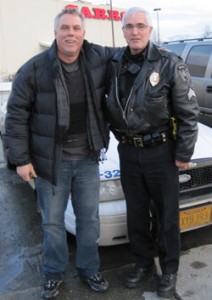
The community is taking steps in the right direction. While I was there, the city changed a few zoning laws, paving the way for a “housing first” model to be established. I am also encouraged that homeless services providers from across the city are working together to find a solution. But the problem is severe. Being candid, I’ve never seen anything like it. Being that the issue is alcohol dependence at its worst, the normal recovery models may not work. I’ve read about wet shelters saving money and lives, so maybe that is the model of hope for Anchorage. I do know now that I very much want to visit and interview people running a successful wet shelter.
The people of Anchorage are some of the nicest I’ve ever experienced. I just pray that they can work out the issues between themselves and come up with a viable solution before more people die from alcohol. There is no easy solution to the complex issue of homelessness. It’s impossible to make everyone happy, yet a compromise must be made and action must be taken soon.
We must never give up on people
Remember the self-disclosure of my own alcoholism at the beginning of this post? Well, this August I will have fifteen years completely clean and sober. People can change for the better. But I’m only sober today because someone cared enough to love me when I could not love myself. Please, never give up on people – even those of us who have trouble with alcohol.







